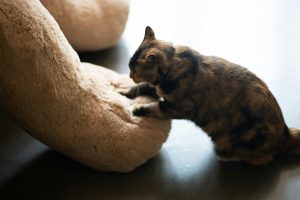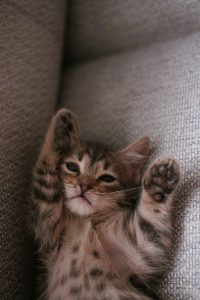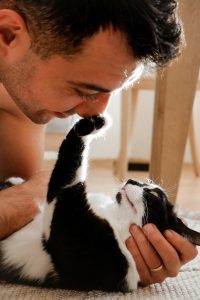In This Article
ToggleLast updated on February 3rd, 2025 at 11:06 pm
Have you ever watched your cat ‘make biscuits’ on your lap, rhythmically pressing their paws in and out? This adorable behavior, called kneading, is more than just a cute habit. It’s a window into your cat’s emotions and a reminder of their deep-rooted instincts. Many cat owners observe this endearing behavior but may not fully understand why it happens. Are you ready to decode your cat’s mysterious behaviors and grow your connection?
Let’s explore the fascinating world of feline kneading and discover the hidden meanings behind this endearing behavior.
Why Do Cats Knead?
Ever wonder why your cat loves to ‘make biscuits’ on your lap? This rhythmic paw-pushing isn’t just a cute habit – it’s a deep-rooted instinct with fascinating origins. Let’s uncover the secrets behind why cats knead:

Instincts from Kittenhood
Did you know your cat’s ‘biscuits’ have a surprising origin? Kittens start kneading while nursing, gently massaging their mother’s belly to stimulate milk flow. This comforting action is deeply ingrained, and many cats carry it into adulthood as a way to feel safe and secure, just like they did as tiny kittens.
Marking Territory
Did you know your cat might be ‘marking’ their territory when they knead on you? Their paws have special scent glands, and kneading releases their unique scent onto surfaces. This is their way of claiming their space and making it feel safe and familiar.
Comfort and Stress Relief
Kneading isn’t always about marking territory. Often, it’s a sign of pure contentment. Your cat might knead before settling down for a nap, using the rhythmic motions to relax and unwind. It’s like their own version of stress relief, a comforting ritual that helps them feel safe and secure.
Chemical Signals and Cat Marking
Did you know your cat’s paws release special scents when they knead? These ‘happy hormones’ not only mark their territory but also send messages to other cats that a space is “taken.” It’s like their secret code, letting other felines know this spot is theirs! This fascinating behavior connects to a whole world of feline communication. Kneading is far more than a cute or quirky habit—it’s a multi-faceted behavior rooted in instincts, emotional comfort, and communication. Understanding this behavior helps you connect with your cat on a deeper level and appreciate the complexities of their world.
Other Common Feline Behaviors
Ever wondered what your cat is trying to tell you? Cats have a whole language of their own, from playful swats to slow blinks. Let’s decode some of these curious feline behaviors and learn to understand what our furry friends are really saying:
Belly flashes reveal trust
Ever wonder why your cat suddenly flops over and shows you their belly? It might seem like an invitation for a tummy rub, but in the cat world, it’s a complex signal. Sometimes it means ‘I trust you completely!’, while other times it’s a clever way to prepare for a quick defense.
- Trust or Submission: Showing their belly can be a big deal for a cat! It’s often a sign they really trust you, kind of like saying, ‘I feel safe with you.’
- Defensive Posture: In some cases, it may be a strategic position, allowing the cat to use all four claws if threatened.
- Body Language in Cats: Cats use their body to communicate affection, fear, or hostility. Relaxed muscles and slow movements suggest trust, while tense muscles and quick, jerky motions signal fear or aggression.
Purring heals and comforts
We all love that sweet purring sound, but did you know there’s more to it than just happiness? Let’s discover the surprising reasons why cats actually purr.
- Mechanisms of Purring: Purring occurs through rapid vibrations of the laryngeal muscles, creating a rhythmic sound. Purring isn’t just about feeling good. It’s how cats tell us they’re comfortable and relaxed.
- Physical and Chemical Signals: Cats may purr to communicate comfort or signal their non-threatening intentions.
- Stress Relief: Rubbing and petting often encourage purring, which helps reduce stress for both cats and humans.
- Healing Vibrations: Studies suggest that purring, with its specific frequency, may promote healing and bone growth, linking it to physical well-being.
Slow retreats show caution
Ever watched two cats carefully observe each other, then slowly back away? This isn’t just any walk – it’s a deliberate move with a hidden meaning. Slow walking in the cat world is all about maintaining peace and making sure everyone knows their boundaries. It’s a subtle way of saying, ‘I’m not a threat, but I’m also not backing down.
- Territorial Behavior: Cats are territorial creatures, and walking away slowly can signal an attempt to avoid confrontation.
- Avoidance Tactics: This behavior often occurs when a cat wants to de-escalate a situation without appearing submissive.
- Body Language: Ear positions and tail movements provide additional clues. A high tail denotes confidence, whereas flattened ears could symbolize unease.
Closed doors spark curiosity
Ever wondered why your cat seems obsessed with closed doors? It’s all about their curious nature and their need to explore! Cats are naturally independent and love to roam their territory. A closed door feels like a forbidden challenge, blocking their access and sparking their curiosity. Cats love to be in charge, so a closed door can feel like a big obstacle! It blocks their freedom to explore and makes them feel like they’re not in control of their territory. Plus, that closed door is a mystery! What exciting adventures could be happening on the other side? They’re naturally curious and driven to investigate. And let’s be honest, sometimes they just want your attention. Pawing at a closed-door might be their way of saying, ‘Hey, I’m here and I want to be part of the action!’
Licks signal love marks
- Affection and Bonding: Licking is a grooming behavior that cats use to show affection and mark you with their scent, signaling that you are part of their “family.” They might even be trying to claim you as their own!
- Marking Behavior: Cats also use licking to claim ownership of you, reinforcing their bond.
- Discomfort or Overstimulation: However, excessive licking can indicate stress or overstimulation, so it’s important to observe the context.
By understanding these common feline behaviors, you can better interpret your cat’s body language and responses, deepening the connection you share.
What Does It Mean When a Cat Purrs and Kneads?
When a cat purrs and kneads, it usually means they are feeling happy, comfortable, or content. Cats knead by pressing their paws in and out on soft surfaces, like your lap, blankets, or even your clothes. They often purr when they feel safe and relaxed. Together, these actions show that the cat feels good and enjoys being around you.
Kneading is an instinctive behavior that cats learn as kittens when they knead their mother’s belly to help with milk flow. As adult cats, they continue kneading to comfort themselves and show affection.

Why Does My Cat Knead Me and Purr?
When your cat kneads and purrs while sitting with you, it’s a sign that they trust you and feel comfortable around you. Cats don’t just do this with anyone—they reserve kneading and purring for the people or places they feel most relaxed and safe with.
It’s their way of showing love and affection. Kneading and purring together can also help them feel calm and content. If your cat does this, they are telling you they like being near you and are comfortable in their surroundings.
What Does It Mean When a Cat Kneads and Purrs?
When a cat kneads and purrs, it’s usually a sign of happiness. The purring shows they are content, and the kneading helps them feel relaxed, similar to how we might stretch or wiggle when we’re comfortable. Cats may also knead and purr when they are settling in for a nap, as it helps them feel more at home and cozy.
In addition, some cats might knead and purr to mark their territory. Cats have scent glands in their paws, and when they knead, they are leaving their scent behind, making the area feel more like home.
Do Cats Knead When Stressed?
While kneading is generally a sign of comfort, it can also be a way for cats to comfort themselves when they are stressed or anxious. For example, if they’re in a new place, around loud noises, or feeling unsure, they might knead to help calm themselves.
Even though kneading happens most often when a cat is relaxed, it can also act as a self-soothing behavior, much like how people might rub their hands together when they feel nervous or scared.
Why Do Cats Purr and Knead at the Same Time?
When cats purr and knead at the same time, it’s a combination of them feeling completely comfortable and happy. Purring is a natural sign of contentment, while kneading is something they do when they feel safe, especially with their favorite humans or in a familiar place.
In fact, purring and kneading together can be a way for a cat to express both relaxation and affection. It’s like saying, “I’m happy, and I feel good right here with you.” Some cats might even do this when they are resting or preparing to sleep.
What Does It Mean When Kittens Purr and Knead?
Kittens knead and purr as part of their instinctive behavior from birth. When they’re nursing from their mother, they knead her belly to stimulate milk flow, and they purr to show contentment and comfort. This behavior is often carried into adulthood, even after they are no longer nursing.
As adult cats, they continue to knead and purr when they are feeling secure and content. When you see a kitten knead and purr, it’s a sign they are feeling safe and happy, just as it is for adult cats. It’s a way for them to express love and comfort, not just when they are young, but throughout their lives.

Understanding Cat Reactions
Cats may display sudden or unexpected reactions, such as going “mad” when touched or showing unexplained aggression. These behaviors often have underlying causes rooted in their physical or emotional state. Let’s explore these reactions:
Touch triggers feline overstimulation
Ever try to pet your cat, only to have them suddenly lash out? It can be frustrating, but there’s usually a good reason for their unexpected reaction. They might simply be feeling uncomfortable or overwhelmed.
- Discomfort or Pain: Has your usually cuddly cat suddenly become grumpy and reactive? It’s important to remember that cats can feel pain just like us! Arthritis, injuries, or even sensitive skin can make certain touches uncomfortable.
- Overstimulation: Cats can become overwhelmed by prolonged petting or touch, leading to a sudden aggressive response. Watch for signs such as tail flicking, skin twitching, or ears flattening as warnings – these are their way of saying, ‘Back off!’
- Aging or Cognitive Decline: Older cats can also become more sensitive or confused due to age-related changes. If your senior cat is suddenly acting out, it’s best to consult your vet to rule out any underlying health issues.
Aggression masks hidden pain

Is your usually sweet cat suddenly acting grumpy and aggressive? There’s usually a reason behind it, even if it’s not always obvious.
- Pain or Fear: Aggression in cats is a sign that something’s wrong. They might be in pain, scared, or feeling threatened.
- Lack of Socialization: If your cat wasn’t properly socialized when they were young, they might be more likely to act out around people or other animals.
- Chemical Cues to Leave Messages: Aggressive behavior may also involve releasing pheromones or displaying territorial markers to send a “stay away” message to perceived threats. This chemical communication is part of their natural instinct to protect their space.
Understanding the root causes of your cat’s reactions can help you address their needs effectively. Observing their body language, identifying triggers, and consulting with a veterinarian when needed are key steps in managing these behaviors.
Emotional Connection Between Cats and Humans
Cats aren’t just cuddly companions – they form deep emotional bonds with us! But how do they show their love? Understanding their unique ways of expressing affection can help you build a stronger relationship with your furry friend. Let’s explore the fascinating world of feline emotions!
Cries reflect strong bonds

Do cats really miss us? While they might not cry like humans, they certainly have ways of showing their feelings. Some cats might meow more or make other sounds when they’re looking for attention or feeling lonely. It’s their way of letting us know they need us!
- Vocalizations and Emotional Expression: While not necessarily “crying” in the human sense, cats do make various sounds, like meowing or yowling, to communicate their needs. These vocalizations may increase when they are anxious or want to express affection or Sometimes they meow to tell us they’re happy to see us,
- Why They Cry: If your cat cries for you, it may be seeking comfort, attention, or reassurance. It’s their way of letting you know they want your presence or care.
Cats choose favorite people
Absolutely! Just like us, they form stronger bonds with the people who give them the most love and attention. It’s all about who they feel most comfortable and connected with.
- Bonding Through Attention: Cats tend to gravitate toward the person who consistently provides them with food, play, and affection. Their favorite person is often the one who meets their needs – food, playtime, and lots of cuddles and makes them feel safe.
- Positive Interactions: Cats can be selective in their affection. They bond with the person who respects their space, but also provides a reliable source of interaction, whether it’s petting, playing, or quiet companionship.
Sadness sensed by cats
You bet they can! Cats are incredibly perceptive and can sense your emotions. They’re like furry little mood readers!
- Sensitivity to Human Emotions: Cats pick up on physical cues, such as body language and changes in voice tone, as well as chemical cues like pheromones that humans emit during emotional states.
- How They Respond: When you’re sad, your cat might cuddle up close, purr softly, or gently nuzzle you, offering comfort in their own way. It’s truly heartwarming how they offer their own unique brand of consolation.
Leaving triggers feline sadness
Yes, some cats experience separation anxiety when their owners leave, and it can affect their behavior. Just like us, cats can get really attached to their humans! So, it’s no surprise that some cats get anxious when you leave the house. They might cry, groom themselves excessively, or even hide. If your cat seems really upset when you’re gone – maybe they scratch furniture, knock things over, or even act destructively – they might be suffering from separation anxiety. This is common in cats who have a strong bond with their owners.
Fascinating Facts About Cats
Cats are enigmatic creatures, and there’s still so much to learn about their behavior and capabilities. Here are some fascinating facts that dive deeper into the mysteries of our feline friends:

Do Cats Dream?
Yes, cats do dream! Like humans, cats experience REM (Rapid Eye Movement) sleep, a stage where dreaming is most likely to occur. Ever wonder what your cat dreams about? where their eyes dart back and forth and their paws might twitch. This suggests they’re dreaming! We can’t know for sure what’s going on in their kitty dreams, but it’s likely they’re reliving their day – maybe chasing imaginary mice or playing with their favorite toy.
Can a Cat Get Jealous?
Yes, cats can experience jealousy, particularly when they feel their territory or relationship with their owner is being threatened.
- Behavioral Signs of Jealousy: Cats may show jealousy by becoming more aggressive or vocal when they see their owner giving attention to another pet or person. They might try to get between you and the “competitor” or display behavior like marking, excessive grooming, or even acting out.
- How to Address It: Provide your cat with individual attention and positive reinforcement to help reduce jealousy. Keep their routine predictable and make sure they feel secure in their environment.
Cats understand familiar names
Can cats really understand their names? Yes, cats can understand their names, although they may not always respond to them as dogs do. Studies show that they can! They seem to recognize their own names, especially when you say them in a friendly, happy voice. Try calling your cat’s name – you might notice them turning their head or ears towards you. It’s all about the tone! Cats are very sensitive to how you sound. They’re more likely to respond when you speak to them calmly and gently.
Being held shows trust
Do your cats love to be held? Not all cats enjoy being picked up, but many do—depending on their personality and previous experiences. Some cats enjoy snuggles in your arms, especially if they were handled a lot when they were kittens. But not all cats feel the same way! If your cat stiffens up, scratches, or tries to wriggle free when you pick them up, they’re probably not enjoying it. A relaxed posture and a happy purr are good signs they’re comfortable being held.
Talking strengthens feline bonds
Did you know that the way you talk to your cat matters more than what you actually say? Yes, cats appreciate verbal communication, but how you talk to them matters. Cats are really good at understanding the tone of your voice. Speaking to them softly and gently is much more likely to get their attention and make them feel happy. Try it out – talk to your cat in a soothing voice, and you might be surprised by how they respond! Some cats might even ‘talk back’ with meows or chirps.

Conclusion
So, you’ve learned all about your cat’s ‘biscuits’! From kneading to purring, these seemingly simple behaviors tell us a lot about how your cat feels. Understanding their language helps you build a stronger bond and enjoy a deeper connection with your furry friend.
By paying attention to their cues and responding in a way they understand, you’ll create a stronger, more trusting relationship. After all, the more you know about your cat, the better you can understand and care for them!







